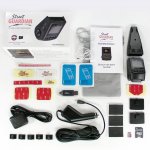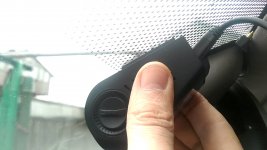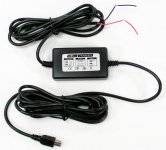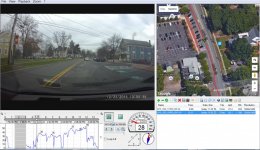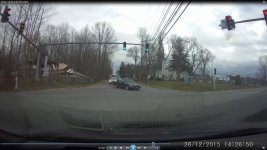ccclarke
Seasoned Member
This thread is for anyone considering adding a dashcam to their cars. I did a lot of research beforehand, trying to get the most bang for the least buck. You can pay more, (or less) but the unit I chose is a good compromise between price and performance, and is considered a best buy at the time of writing.
Why a dashcam? In some countries, they're pretty much mandatory, due to high accident rates and iffy insurance regulation. Where I live, the drivers are . . . challenging. I've driven in enough places to know it's pretty dangerous here and come home with a new death-defying commute story almost nightly. Nothing illustrates the point better than a video of the event. And now, when something happens, I've got a permanent record, which would be handy should I ever need it in court, --for myself or any other driver victimized by what passes for driving in these parts. With a half-dozen years to go before I'm done here, it isn't a question of IF, but WHEN I'm involved in some sort of accident. California was tame by comparison.
Another use I hope I never need it for is if someone smacks into my car while parked. A g-sensor activates the camera for a set amount of time. This is a new feature Cadillac is coming out with on the CT6. If the car alarm goes off, all four perimeter cameras start recording.
Besides, it's a cool mod for my car. When my wife asked me what I wanted for Christmas, I gave her a link and waited for Santa to drop by. Mixed in with a few lumps of coal, I found the dashcam box, and started the installation, which was easy and fun.
The majority of dashcams are made in China and Korea. Dashcams aren't nearly as popular in the US, but their numbers are growing. The body style/form factor of this model is popular, and a few (Chinese) clones have sprung up. That said, Street Guardian is a Chinese company, but has US and Australian sales reps. I've opened the body and GPS antenna up and can vouch for the internal workmanship as being an 8.5 on a scale of 10. (I train and certify NASA-level solder operators as a collateral duty at work.)
Lets, begin with the unit. The highly-rated Street Guardian SG9665GC costs $200 and is available on amazon.com from the US Distributor, Pier 28. It connects to the cigarette power outlet, but I'm no fan of loose wires in the cabin, so I opted for the recommended $34 Cell Power CPUSB01 12v to 5v mini-USB converter. (This appears if you look at the dashcam on Amazon at the bottom of the page.) Just to be clear, the dashcam comes with everything you need to get started. A longer-winded review than I could ever write is here: https://www.youtube.com/watch?v=0xJVx2DmxOQ
Comparisons: Getting dashcam educated is easy --once you know where to look. I'm a big fan of side-by-side comparisons (as long as they don't involve me standing in a suspect line-up.) This model is at the bottom of the "Best Bang For The Buck" section: https://dashcamtalk.com/
Support after the sale is something we all like, and I have not been able to find a dashcam company that does this better than Street Guardian. Their online forum dedicated to this model is a lot like the XLR-net, with lots of enthusiasts chiming in with their experiences, and the company reps responding almost simultaneously with technical answers or product support if things aren't right.
You can judge for yourself here: https://dashcamtalk.com/forum/forums/sg9665gc.159/
Installation: Before I hard-wired the unit in, I watched a couple of YouTube installation videos and then spent about ten minutes putting it in. The 3M double-backed adhesive tape sets up in 20 min, but I let it sit overnight before attaching the dashcam to the mount. Because of sensors in my rear-view mirror, I placed it to the left, high enough for the lens to be just below the upper windshield tint. This also makes gives easy access to the tiny 32Gb storage car from the left side. I mounted the GPS antenna to the right of the mirror after flipping the internal antenna as per the instructions. For a dash-mount installation, the antenna doesn't need to be adjusted. The dashcam is nearly invisible from the outside.
Testing:
Before hard-wiring the unit, I had to play with it. Of course, the first daytime video was a run to the local liquor store! Even in light rain, the 1080P video output was almost as excellent as the scotch I picked up. That night, I made another drive around town to observe how responsive it worked on lighted (and dark) roadways. It was still raining, and I wanted to see how much light streaking was evident. I passed two police cars with lights ablaze next to a sideways SUV resting against a Jersey barrier that had spun out; the light levels were not overpowering as I would have expected on such a dark stretch of highway.
This device uses HDR (High Dynamic Ranging) which means it automatically corrects at the pixel level how bright the display looks. You don't want an oncoming car's headlights to wipe out the display. On my commute the other morning, headlights and street lamps were on, but I could still see a sliver of the moon with Venus just above it. That's excellent light level discrimination in my book.
Video Storage:
All video is stored on a micro-SD card, about the size of a pinkie fingernail. (Unless you have gorilla hands.) To transfer the acquired video, the tiny card is removed and placed in a SD card adapter that plugs into a slot on my computer. When configuring the unit, you specify how long each back-to-back (sequential) video file should last. My commute is only twenty minutes, so my files are five minutes long, yielding four each way. This makes it easy to go back later if I need to search for something. All are date/time-stamped too.
Due to the heavy rake of my windshield, (the XLR would be very close in angle) I picked up reflections that covered about 25% of the windshield area during my initial testing. While annoying, it wasn't a show-stopper. At night, it was about half as bad. A Circular Polarizing Filter is available for $40, so I ordered and installed it. Reflections are reduced by more than half, so it was a good decision.
Software:
No software comes with the camera. There are two (free!) programs that support this camera, and I like both of them. When recording, metadata is stored along with video that includes GPS coordinates. This gives you the ability to watch (in real time Google maps) an overhead view as well as the dashcam view, along with speed and other data.
Firmware Support:
Street Guardian listens to their customers on the forum and issues free firmware updates when new features are added or bugs are discovered.
Hardwiring:
Again, this was easy. The pictures of the 12v to 5v converter don't adequately show how tiny the thing is. I ran the wires from the upper edge of the windshield to the A pillar, under the dash and to the center console power receptacle, using in-line splices to tap the ignition-switched power. Nylon trim tools made that a lot easier, and it might have taken an hour, going slowly to ensure nothing would be pinched. Small tie wraps ensured there would be no rattles.
This mod isn't for everyone, but for those that wish to add it to their cars, I think this is a cool addition. Feel free to ask any questions and I'll try to answer them. I've included a few pictures as well including a guy who cut me off as soon as the light turned green. (Very common here. . . )
CC
Why a dashcam? In some countries, they're pretty much mandatory, due to high accident rates and iffy insurance regulation. Where I live, the drivers are . . . challenging. I've driven in enough places to know it's pretty dangerous here and come home with a new death-defying commute story almost nightly. Nothing illustrates the point better than a video of the event. And now, when something happens, I've got a permanent record, which would be handy should I ever need it in court, --for myself or any other driver victimized by what passes for driving in these parts. With a half-dozen years to go before I'm done here, it isn't a question of IF, but WHEN I'm involved in some sort of accident. California was tame by comparison.
Another use I hope I never need it for is if someone smacks into my car while parked. A g-sensor activates the camera for a set amount of time. This is a new feature Cadillac is coming out with on the CT6. If the car alarm goes off, all four perimeter cameras start recording.
Besides, it's a cool mod for my car. When my wife asked me what I wanted for Christmas, I gave her a link and waited for Santa to drop by. Mixed in with a few lumps of coal, I found the dashcam box, and started the installation, which was easy and fun.
The majority of dashcams are made in China and Korea. Dashcams aren't nearly as popular in the US, but their numbers are growing. The body style/form factor of this model is popular, and a few (Chinese) clones have sprung up. That said, Street Guardian is a Chinese company, but has US and Australian sales reps. I've opened the body and GPS antenna up and can vouch for the internal workmanship as being an 8.5 on a scale of 10. (I train and certify NASA-level solder operators as a collateral duty at work.)
Lets, begin with the unit. The highly-rated Street Guardian SG9665GC costs $200 and is available on amazon.com from the US Distributor, Pier 28. It connects to the cigarette power outlet, but I'm no fan of loose wires in the cabin, so I opted for the recommended $34 Cell Power CPUSB01 12v to 5v mini-USB converter. (This appears if you look at the dashcam on Amazon at the bottom of the page.) Just to be clear, the dashcam comes with everything you need to get started. A longer-winded review than I could ever write is here: https://www.youtube.com/watch?v=0xJVx2DmxOQ
Comparisons: Getting dashcam educated is easy --once you know where to look. I'm a big fan of side-by-side comparisons (as long as they don't involve me standing in a suspect line-up.) This model is at the bottom of the "Best Bang For The Buck" section: https://dashcamtalk.com/
Support after the sale is something we all like, and I have not been able to find a dashcam company that does this better than Street Guardian. Their online forum dedicated to this model is a lot like the XLR-net, with lots of enthusiasts chiming in with their experiences, and the company reps responding almost simultaneously with technical answers or product support if things aren't right.
You can judge for yourself here: https://dashcamtalk.com/forum/forums/sg9665gc.159/
Installation: Before I hard-wired the unit in, I watched a couple of YouTube installation videos and then spent about ten minutes putting it in. The 3M double-backed adhesive tape sets up in 20 min, but I let it sit overnight before attaching the dashcam to the mount. Because of sensors in my rear-view mirror, I placed it to the left, high enough for the lens to be just below the upper windshield tint. This also makes gives easy access to the tiny 32Gb storage car from the left side. I mounted the GPS antenna to the right of the mirror after flipping the internal antenna as per the instructions. For a dash-mount installation, the antenna doesn't need to be adjusted. The dashcam is nearly invisible from the outside.
Testing:
Before hard-wiring the unit, I had to play with it. Of course, the first daytime video was a run to the local liquor store! Even in light rain, the 1080P video output was almost as excellent as the scotch I picked up. That night, I made another drive around town to observe how responsive it worked on lighted (and dark) roadways. It was still raining, and I wanted to see how much light streaking was evident. I passed two police cars with lights ablaze next to a sideways SUV resting against a Jersey barrier that had spun out; the light levels were not overpowering as I would have expected on such a dark stretch of highway.
This device uses HDR (High Dynamic Ranging) which means it automatically corrects at the pixel level how bright the display looks. You don't want an oncoming car's headlights to wipe out the display. On my commute the other morning, headlights and street lamps were on, but I could still see a sliver of the moon with Venus just above it. That's excellent light level discrimination in my book.
Video Storage:
All video is stored on a micro-SD card, about the size of a pinkie fingernail. (Unless you have gorilla hands.) To transfer the acquired video, the tiny card is removed and placed in a SD card adapter that plugs into a slot on my computer. When configuring the unit, you specify how long each back-to-back (sequential) video file should last. My commute is only twenty minutes, so my files are five minutes long, yielding four each way. This makes it easy to go back later if I need to search for something. All are date/time-stamped too.
Due to the heavy rake of my windshield, (the XLR would be very close in angle) I picked up reflections that covered about 25% of the windshield area during my initial testing. While annoying, it wasn't a show-stopper. At night, it was about half as bad. A Circular Polarizing Filter is available for $40, so I ordered and installed it. Reflections are reduced by more than half, so it was a good decision.
Software:
No software comes with the camera. There are two (free!) programs that support this camera, and I like both of them. When recording, metadata is stored along with video that includes GPS coordinates. This gives you the ability to watch (in real time Google maps) an overhead view as well as the dashcam view, along with speed and other data.
Firmware Support:
Street Guardian listens to their customers on the forum and issues free firmware updates when new features are added or bugs are discovered.
Hardwiring:
Again, this was easy. The pictures of the 12v to 5v converter don't adequately show how tiny the thing is. I ran the wires from the upper edge of the windshield to the A pillar, under the dash and to the center console power receptacle, using in-line splices to tap the ignition-switched power. Nylon trim tools made that a lot easier, and it might have taken an hour, going slowly to ensure nothing would be pinched. Small tie wraps ensured there would be no rattles.
This mod isn't for everyone, but for those that wish to add it to their cars, I think this is a cool addition. Feel free to ask any questions and I'll try to answer them. I've included a few pictures as well including a guy who cut me off as soon as the light turned green. (Very common here. . . )
CC

